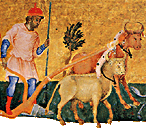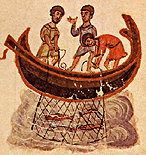Agrarian economy
 he economy of the Late Byzantine period retained its rural character.
he economy of the Late Byzantine period retained its rural character.
 It was mainly based on farming, but also included the raising of livestock, apiculture, fishing and forestry. Farmers grew a variety of crops, such as cereals and pulses, and cultivated the vine and the olive and various fruit trees. It was mainly based on farming, but also included the raising of livestock, apiculture, fishing and forestry. Farmers grew a variety of crops, such as cereals and pulses, and cultivated the vine and the olive and various fruit trees.
The status of the owner of a piece of land determined the category that land came under, and it is interesting to examine the evolution of the system of land ownership. A special feature of the agrarian economy of the last centuries of Byzantium is the concentration of land in the hands of great landowners - laymen or clerics.
 The institution of pronoia played an
important part in this direction. Even though the pronoia had already existed in the Middle Byzantine period, the system was developed and applied to a much wider extent in the Late Byzantine period. It also greatly influenced the productivity relations that eventually prevailed in the Byzantine state. The institution of pronoia played an
important part in this direction. Even though the pronoia had already existed in the Middle Byzantine period, the system was developed and applied to a much wider extent in the Late Byzantine period. It also greatly influenced the productivity relations that eventually prevailed in the Byzantine state.
These characteristics led to the further growth and development of the feudal elements that had already made their appearance in Byzantium in the previous period. Mention of the word "feudalism" inevitably leads to a comparison with Western feudal models. Such a comparison, however, only serves to bring out the particularities presented by the Byzantine feudal system.
|